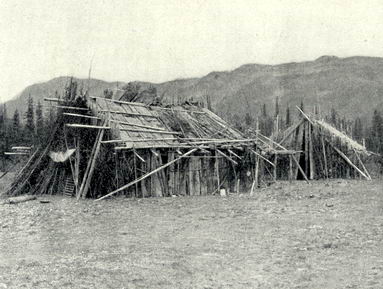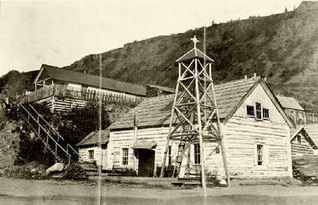
Tahltan guide Nanuk (right) with an American tourist hunter, Glenora, 1933. Photo: George Ball (Click to enlarge) |
|||||

Glenora, Stikine River, Tahltan Territory, 1874. Jennie Martin, Telegraph Creek, c. 1890. Telegraph Creek, 1897. "Potlatch for Charlie Jones," Telegraph Creek, c. 1898. Tahltan youth, possibly Telegraph Creek, c. 1898. Pack train at Telegraph Creek, c. 1898. "Meat drying outside an Indian family's tent," Stikine River, 1899. Joe Coeburn, Tahltan chief, Wrangell, c. 1900. Tahltan lodge for smoking salmon, Salmon Creek, c. 1900. "Tahltan Billy," c. 1909. "The high ranking people were the headmen (and their families) and the wealthy (and their families). The headman inherited his position. But he did not automatically become headman, he was also chosen by the people. We wanted our headmen to be strong, energetic, wealthy, intelligent, and wise. His wealth was important because it showed that he had the knowledge and skills to become wealthy." Tahltan Class Structure (Tahltan Nation CD Rom). Stikine River at Telegraph Creek, 17 July 1912. Tahltan men, Little Salmon,Yukon Territory, c. 1913. The three photographs of five Tahltan individuals were all taken in 1913 in Little Salmon, Yukon Territory. In the above photo (from left to right) is Kujin, Demozella and unknown. According to a note, Demozella was dying of tuberculosis at the time. The photo on the right shows a Tahltan woman by the name of Taschoa, from Little Salmon in Yukon Territory. An archival note makes the point that she is wearing large fur cape and has a ring through her nose. "Little Salmon" was also the name of one of the 13 Indian Reserves the Tahltan were allotted by the Government of Canada. Benny Frank with Silver tip Grizzly, c. 1920. Pack train with hunting trophies, Telegraph Creek, c. 1930. George Ball, Stikine, c. 1932. "Nanuk, with his favourite, Maude S," 1931. Dease Lake Store, 1936. Confirmation, St. Aidan's Church, Telegraph Creek, c. 1943. Telegraph Creek, 23 August 1956. |
"Face of the Great Glacier, Stickeen River," 1879. Archival photos of First Nations people rarely record the original names of the individuals in their own language. Most often the names recorded were those given by colonial officials and missionaries. Other essential missing information included which clan the person belonged to. "Our clan system is important. It is a way that we can see where we belong. Our Tahltan names are inherited. Names belong to specific Family groups. That means that names are either Wolf or Crow. A child's name comes from the mother's side of the family" (Naming, Tahltan Nation CD Rom). Julia Campbell, c. 1890. "Long ago, a potlatch was given for the deceased a year after the death. Everyone who died had a potlatch given for them: children, men and women. The potlatch was a ceremony which included dancing, a feast, and a give away ceremony. It lasted from two to four days, depending on the wealth and importance of the deceased. The feast for the deceased was only for the members of the opposite Clan, but everybody who wished to, attended and were welcomed and fed" Death and Funerals (Tahltan Nation CD Rom). The photo of the potlatch for Charlie Jones (left) is remarkable because at the time the participants could have been jailed. The Indian Act was revised in 1884 to outlaw the potlatch system of government, forcing it to go underground until the law was finally revoked in 1952. During this repressive time during which many Indian rights were taken away there were few photographs of the potlatch. Mary Jackson, Telegraph Creek, c. 1898. Calbraith's store and church, Telegraph Creek, c. 1898. Joe Williams and Ah-clem, c. 1900. Mary Jackson, Telegraph Creek, 1901. Billy Neehas and his son, Telegraph Creek, c. 1908. The 1909 photo entitled "Tahltan Bill" (left) was a staged portrait taken in a professional studio for the purposes of marketing as a postcard image. The 1908 photo of Billy Neehas (above) and his son was taken at about the same time but is informal, taken on the spot in Telegraph Creek. "Talakoten" is the Tahltan name of the Neehas family: "This Family's area is named from tala, which means point. This is the narrow strip of land where the Tuya and Tanzilla Rivers join the Stikine. There are no surviving members of this Family. People in this Family group included: Geordie Williams, Billy Nehas and Lame Dick" Tahltan Nation CD Rom. Chief Dandy Jim, Tahltan head man, n.d. Tahltan man, Little Salmon, Yukon Territory, c. 1913.
Taschoa, Little Salmon, Yukon Territory, c. 1913. George Adsit, guide at Dease Lake, 1926. Many of the Stikine - Tahltan photos were donated to the British Columbia Archives by Georgiana Ball, daughter of George Ball, a white guide outfitter who lived in Telegraph Creek from 1912 until his death in 1955 (left). Georgiana is writing a book on the history of the Stikine which will include some of the stories told to her by Tahltan elder Emma Brown (1888 - 1994), whom she affectionately regarded as her grandmother.
Big game trophies, Dease Lake, c. 1930. "Nanuk, at fly camp," 1931. Group at Paddy's Lake, Telegraph Creek, c. 1933. I. Calbraith, Ed Asp Sr, P. Inkster, Telegraph Creek, 1943. Benny Neehas, Telegraph Creek,1960. |
||||
Source: www.firstnations.eu Printed:
Copyright: All Rights Reserved. Researched, written, compiled, formatted, hyperlinked and encoded by Dr. Karen Wonders. Images and intellectual property rights reside with the credited owner. Commercial transmission and/or reproduction requires written permission. Use for educational and research purposes requires proper citation.


































